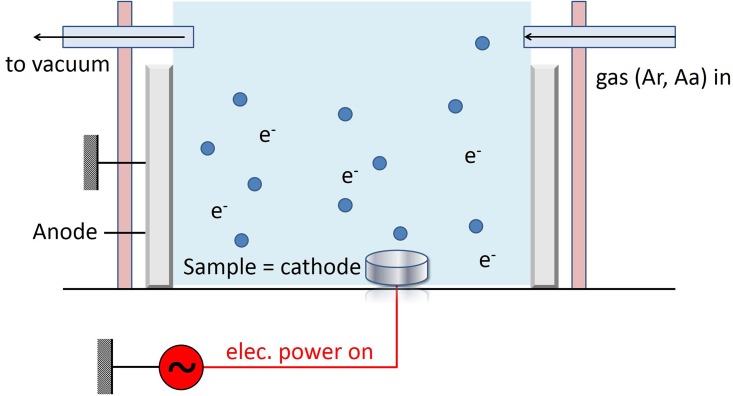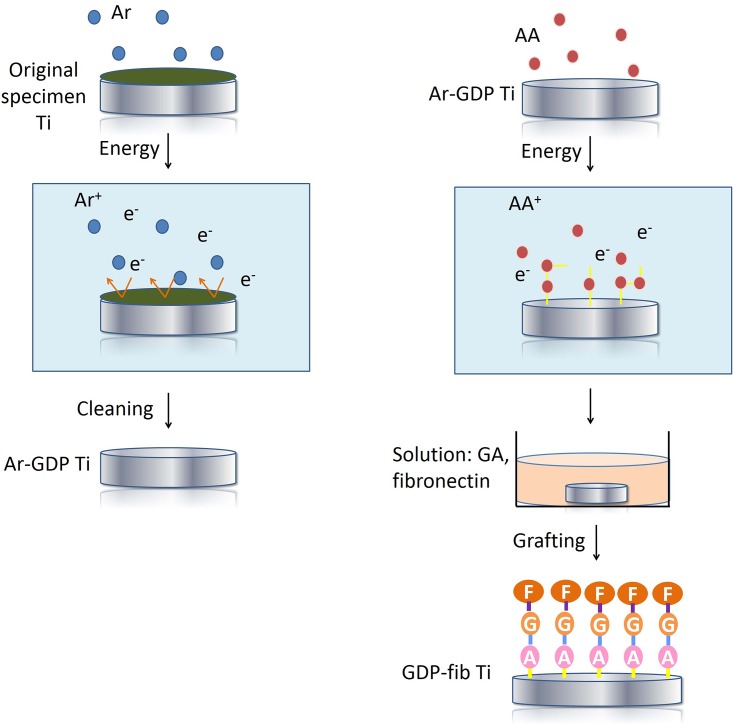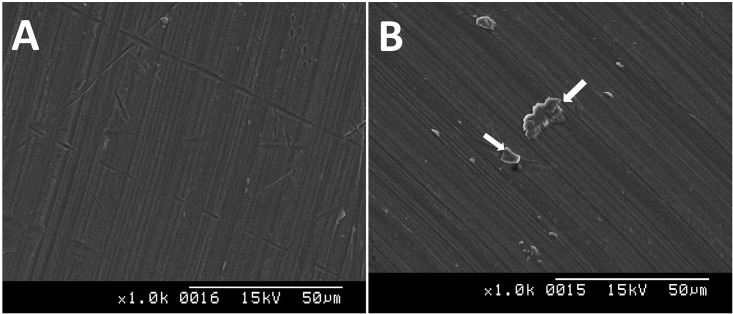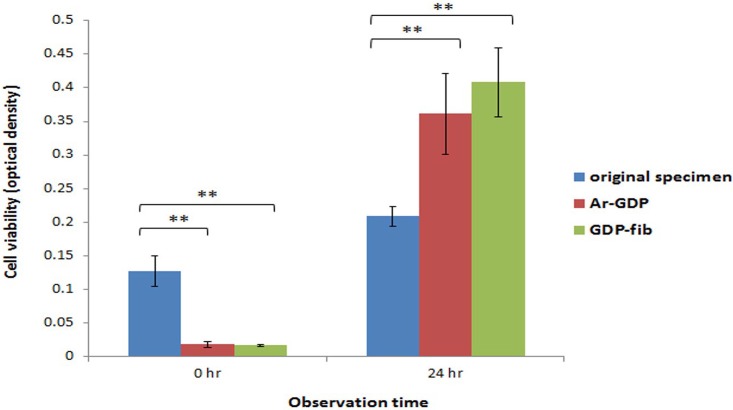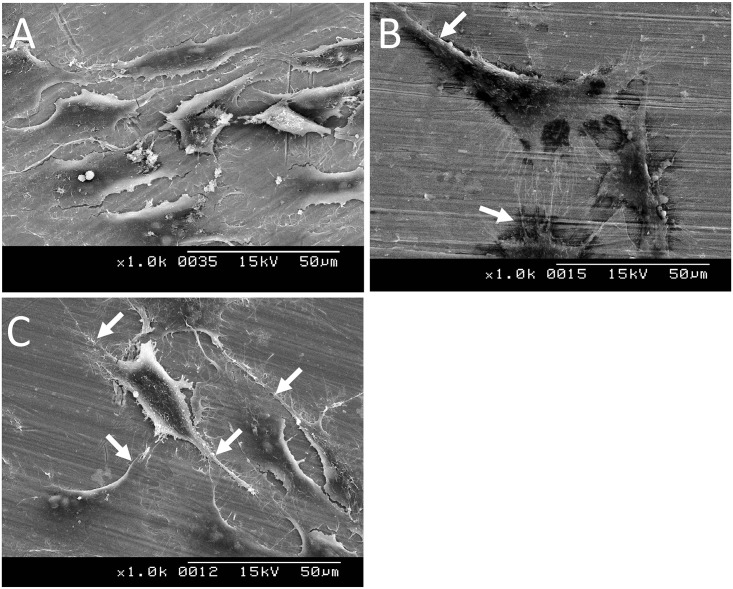Abstract
Background
Glow discharge plasma (GDP) procedure is an effective method for grafting various proteins, including albumin, type I collagen, and fibronectin, onto a titanium surface. However, the behavior and impact of titanium (Ti) surface modification is yet to be unraveled.
Purpose
The purpose of this study is to evaluate and analyze the biological properties of fibronectin-grafted Ti surfaces treated by GDP.
Materials and Methods
Grade II Ti discs were initially cleaned and autoclaved to obtain original specimens. Subsequently, the specimens were GDP treated and grafted with fibronectin to form Ar-GDP (Argon GDP treatment only) and GDP-fib (fibronectin coating following GDP treatment) groups. Blood coagulation test and MG-63 cell culture were performed to evaluate the biological effects on the specimen.
Results
There was no significant difference between Ar-GDP and GDP-fib groups in blood compatibility analysis. While in the MTT test, cellular proliferation was benefited from the presence of fibronectin coating. The numbers of cells on Ar-GDP and GDP-fib specimens were greater than those in the original specimens after 24 h of culturing.
Conclusions
GDP treatment combined with fibronectin grafting favored MG-63 cell adhesion, migration, and proliferation on titanium surfaces, which could be attributed to the improved surface properties.
Introduction
Osseointegration [1], which refers to the process through which the mature living bone establishes a direct structural and functional connection with the implant without any intervening soft or fibrous tissue, is an important phenomenon favoring the effective fixation of implants to bone. Successful osseointegration depends on both the chemistry of the substrate and its surface texture. The surface roughness of titanium implants greatly affects the rate of osseointegration and biomechanical fixation.[2,3] In addition, cell adhesion and spreading are important parameters influencing the implant engineering.
Cellular responses in the vicinity of the implants are strongly affected by surface hydrophilicity, roughness, texture, chemical composition, charge and morphology.[4,5] Given this fact, several studies have attempted to enhance the adhesion and activity of osteoblastic cells on the surfaces by depositing functional proteins onto the titanium surface. [6,7] Of the different methods, glow discharge plasma (GDP) procedure is a popular method for realizing surface modification of biomaterials. Several studies have demonstrated the advantages of GDP method in sterilizing and modifying the surface of the biomaterials [8–10]. The XPS results showed that the Ti surface after plasma treatment was leaving chemistry uncharged.[11] Most importantly, this method offers the possibility of forming bio-functional groups and functional proteins on the titanium surfaces [12,13]. Given all these advantages, this method can be considered as an efficient tool for improving the biocompatibility of biomaterials.
In general, contact between the implants and bone can be improved by adopting surface treatment methods, such as sand blasting, sol-gel dip coating, titanium nitride oxide (TiNOx) coating, plasma spraying, acid etching, and various combinations thereof.[14–16] Furthermore, the biocompatibility of titanium surface could be improved by grafting several functional proteins, such as extracellular matrix proteins (ECM), type I collagen, and albumin using the GDP method.[12,17,18] Bioactive adhesive proteins, such as the extracellular matrix protein fibronectin, have been used to facilitate the surface properties of titanium. The titanium surface with fibronectin coating following GDP treatment were more hydrophilic and had greater surface roughness. Meanwhile, the FITC labeling showed that the number of fibronectin dots on the titanium surface increased positively with the concentration of fibronectin solution used.[19] The attachment of cells through fibronectin binding were measured.[20] The attachment and differentiation of osteoblast-like cells were enhanced on Ti6Al4V titanium surface through fibronectin coating.[21–24] However, the cell culture study on commercially pure titanium (cpTi) remains an important focus of investigation.
Fibronectin is known to play an important role in cell attachment, growth, migration and differentiation. In addition, it is also reported to participate in platelets adhesion and aggregation via the integrin αIIbβ3 (glycoprotein IIb/IIIa) receptors on platelet membrane.[25] However, with the advance of technology, the hemolysis rate and blood coagulation time could be lower and prolonged on titanium surface after fibronectin coating.[26] The blood compatibility of titanium surface with fibronectin coating after GDP treatment has not been studied yet.
To this end, the present study aims to evaluate the biological properties of fibronectin-grafted titanium surface prepared by GDP method. In the process, GDP was used to create bio-functional amine groups on titanium surfaces. Subsequently, fibronectin was grafted onto the amine groups with glutaraldehyde (GA) cross linker. Blood compatibility analysis and cell culture experiments using osteoblast-like cells MG-63 were used to evaluate the bio-functionality of the modified titanium surface.
Materials and Methods
Preparation of titanium surface
10 mm diameter Grade II titanium discs (BioTech One Inc., Taipei, Taiwan) were used in this study. The preparation method was clearly described previously.[18,19] The samples were cleaned in an ultrasound bath with detergent, acetone, and distilled water for 15 min separately to remove the surface contaminants. Subsequently, the cleaned titanium discs were autoclaved at 121°C for 20 min and dried at 40°C in a conventional oven. The titanium discs thus obtained are henceforth referred to as “original specimens.”
Glow discharge plasma cleaning and protein grafting
The original specimens were cleaned by GDP (PJ; AST Products Inc., North Bellericca, MA, USA) with argon. This process involves GDP treatment under argon gas at room temperature under the following conditions: power, 85 W; frequency, 13.56 MHz; pressure, 100 mtorr for 15 min (Fig 1).[19] The titanium discs thus obtained are referred to as “Ar-GDP” (Fig 2a).
Fig 1. Schematic of the flow discharge plasma system.
The blue circles represented the gas ions (argon or allylamine) which were used to modify the titanium surface.
Fig 2. Schematic of sample preparation.
(a)The surfaces of Ti discs (original specimens) were cleaned with argon-based GDP. These titanium discs were then labeled as “Ar-GDP.” (b) Amine groups were grafted onto the Ar-GDP surfaces in the GDP reactor fed with allylamine (AA) gas. These specimens were subsequently treated in glutaraldehyde (GA) and fibronectin solutions and were labeled as “GDP-fib”.
Subsequently, NH groups were adhered onto the titanium surfaces in the GDP reactor fed with allylamine (AA) gas at room temperature under the same conditions as mentioned above except treatment time was increased to 30 min. Thereafter, the specimens were placed in a 3% glutaraldehyde solution (Merck, NJ, USA) for 30 min. Then, the titanium specimens were placed in a solution with 5 μg/ml fibronectin (Sigma-Aldrich Co., St. Louis, MO, USA) for 24 hours to form fibronectin coating on the surface of titanium discs. A tris-phosphate buffer (pH 7.4) was used to stop the chain reaction between amine group and fibronectin (immersed for 30 min).[19] The titanium discs thus obtained are referred to as “GDP-fib” (Fig 2b).
Surface topography evaluation
The surface characteristics of Ar-GDP and GDP-fib were examined with scanning electron microscope (SEM) (Model 2400; Hitachi, Ltd) in order to evaluate the topography of Ti surface after fibronectin coating.
Blood coagulation test
Eight 5 month old New Zealand white rabbits of mean weight 3 kg were used for the analysis. All procedures were approved by the Animal Care and Ethics Committee of Taipei Medical University, Taipei, Taiwan (affidavit of approval No. LAC-2013-0265) (S1 File). The study was conducted according to the principles of the 2010 Basel Declaration. This animal research was conducted in accordance to the ARRIVE (Animal Research: Reporting of In Vivo Experiments) guidelines developed in NC3Rs (National Centre for the Replacement, Refinement and Reduction of Animal Research) (S2 File).[27]
The coagulation of the blood on the surface of blank Petri dish and Ar-GDP and GDP-fib titanium disks were evaluated by using spectrophotometry. Fresh rabbit blood was used for each experiment. During the test, 10 ml of blood from each rabbit was drawn with a syringe with 24G needle (TERUMO Co., Tokyo, Japan) from the marginal vein on the right or left ear under animal fixation with a fixation box. The rabbits were alive and kept for further study after the blood collection. Subsequently, a 200 μl of fresh rabbit blood was placed on the surface of the empty Petri dish and 24-well Petri dishes (Nunclon; Nunc, Roskilde, Denmark) with the titanium samples. After 10, 20, 30 and 40 min, 2 ml of distilled water was placed in the wells and the Petri dishes were subsequently incubated at 37°C for 10 min to disperse the free RBCs. The absorbance values of the wash solutions were colorimetrically measured by using an ELISA reader (Model 2020, Anthos Labtec Instruments, Eugendorf, Wals, Austria) at 540 nm. Each absorbance value represented the average of six measurements.
Blood coagulation of Ar-GDP and GDP-fib specimens were expressed as a percentage and compared to that of the blank plates (100%). The remainders of Ar-GDP and GDP-fib were used for statistical analysis. High absorbance value, which is also demonstrated as the lower absorbance value remainder, implies a low amount of blood coagulation.
Cell vitality test
In the process, MG-63 (ATCC CRL-1427) osteoblast-like cells, at a concentration of 1 × 104 cells/ml, were seeded onto the surface of the original specimen, Ar-GDP and GDP-fib titanium discs in the 24-well Petri dishes (Nunclon; Nunc, Roskilde, Denmark). During all experiments, the cells were initially incubated without medium for 10 hours to ensure attachment. The cells were then cultured in Dulbecco’s modified Eagle’s medium (DMEM; HyClone, Logan, UT) supplemented with L-glutamine (4 mmol/L) with 10% fetal bovine serum (FBS), and 1% penicillin streptomycin. Cultures were incubated in 5% CO2 atmosphere at 37°C and 100% humidity. Accordingly, the time, when DMEM was added, was defined as the 0th hour (T0) for every test.[17]
At 0th (T0) and 24th (T24) hour of culture, the culture media were removed and the discs were rinsed three times with PBS. The samples were then fixed in 2.5% GA and 2% paraformaldehyde solution for 30 min. Subsequently, for post-fixation, the samples were rinsed in 1% osmium tetroxide for 1 hour. The titanium discs were then dehydrated in 70%, 80%, 90%, 95%, and 100% series ethanol and dried in a critical point dryer (HCP-2; Hitachi Ltd, Tokyo, Japan). Thereafter, a thin layer of palladium gold was coated on the samples with a sputter coater (IB-2; Hitachi, Ltd, Tokyo, Japan). The morphological features of the cells were examined by using a Hitachi S-2400 electron microscope (Model 2400; Hitachi, Ltd). Two samples were prepared for each group.
Cell vitality was determined using an MTT ((3–4,5-dimethylethiazol-2-yl)-2,5-diphenyl tetrazolium bromide) reduction assay. Tetrazolium salt (MTT kit, Roche Applied Science, Mannheim, Germany) was added and metabolically reduced to colored formazan by mitochondrial dehydrogenase in viable cells, as indicated in the manufacturer’s instructions. After solubilizing, the formazan dye was added with 500 μl of dimethyl sulfoxide for 5 min. Subsequently, the optical density of the medium was determined by using the ELISA reader at 570 nm. Optical density results were expressed as a percentage of that of the original specimen. In this study, four samples were prepared for each group.
Statistical analysis
Biological characters of the modified titanium surfaces were evaluated by performing hemocompatibility and MTT assay. The morphology of the MG-63 cell cultured samples was observed by using SEM. For all assays, differences between tested groups were evaluated by Student’s t-test. Significance levels were set to P ≤ 0.05.
Results
Surface topography evaluation
The surface of Ar-GDP discs showed planar morphology with parallel grooves (Fig 3a). However, the GDP-fib samples had a homogenous layer with irregular folding structure of protein (Fig 3b).
Fig 3. Scanning electron microscopy images of the Ar-GDP (a) and GDP-fib (b) titanium discs.
Irregular folding of the fibronectin was revealed on the surface of fibronectin-grafted titanium disks (white arrows).
Blood coagulation test
The results of blood coagulation test showed that the hemocompatibility of titanium discs decreased after fibronectin grafting; nevertheless, there was no significant difference between two groups (Fig 4). The hemocompatibility of Ar-GDP and GDP-fib samples were expressed as a percentage and compared to that of the blank plate (100%). The remainders of the Ar-GDP titanium discs were 22.6%, 67.5%, 80.3% and 77.3% at 10, 20, 30 and 40 min of blood coagulation, respectively. Similarly, in the case of GDP-fib discs, the remainders were 15.6%, 54.1%, 68.9% and 65.0% at 10, 20, 30 and 40 min of blood coagulation, respectively. As is seen, the remainder of the Ar-GDP titanium discs was not significantly greater than the GDP-fib discs at each set point of time.
Fig 4. Blood coagulation of Ar-GDP and GDP-fib samples was expressed as percentage and compared to that of the blank plate (100%).
There was no significant difference between two groups.
Cell vitality test
According to the MTT assay analysis, the number of MG-63 cells on Ar-GDP and GDP-fib titanium specimens after 24 hours (T24) of culture was greater than that on the original specimens (Fig 5). Besides, the cells on the original specimens showed significantly less cell proliferation when compared to the cells on the Ar-GDP and GDP-fib titanium discs (P < 0.01). There was no significant difference between the Ar-GDP and GDP-fib groups.
Fig 5. The MTT assay of MG-63 cells.
Compared to the original specimen, both on the surface of GDP-treated and fibronectin-modified titanium, the MG-63 cells viability was significantly enhanced after 24 hours of culture (**P < 0.01).
MG-63 cell morphology evaluation
The MG-63 cells exhibited distinctly different morphologies on the SEM images of original specimens, Ar-GDP, and GDP-fib titanium surfaces. The MG-63 cells SEM images after 24 hours of culture (Fig 6) showed flaky shape cells seeded onto the original specimens (Fig 6a). The MG-63 cells were spread out in an even way and appeared to form a thin and continuous monolayer on the Ar-GDP titanium surfaces (Fig 6b). Nevertheless, morphological alternation of MG-63 cells, from spindle to more stellar shape with extensive filopodia contacting with each other and with the substrate (Fig 6c), could be observed when the fibronectin-grafted titanium discs were used as substrates.
Fig 6. Scanning electron microscopy images of MG-63 cells cultured on original specimen (a), Ar-GDP (b), and GDP-fib (c) titanium discs after 24 h.
Cells showed morphological alternation from spindle to more-stellar shapes, and extensive process (white arrows).
Discussion
The objective of this study was to gain in-depth insights of the biological effects, including hemocompatibility and cellular reaction, of the titanium surfaces after GDP and fibronectin modification. Therefore, we analyzed the surfaces prepared using different methods. The surface roughness and wettability of the modified titanium surfaces have already been reported in previous studies. In the study, fibronectin-grafted specimens had higher hydrophilicity and greater surface roughness than the GDP-treated specimens.[19] The FITC labeling ensured the formation of fibronectin coating. Grafted fibronectin on titanium surface was spotty distribution instead of monolayer formation. In addition, the number of fibronectin dots on the titanium surface increased positively with the concentration of fibronectin solution used.[19]
The normal wound healing process is divided into four stages, namely, hemostasis, inflammatory, proliferative and remodeling phases. Coagulation (thrombogenesis), the process by which blood forms clots, is an important part of hemostasis.[28] The GDP treatment could enhance the adhesion of blood cells onto the surface of the biomaterial, thereby favoring aggregation and blood coagulation on polymer-based biomaterials.[29] Because of the effect, the wound healing and osseointegration will be promoted. In order to improve hemocompatibility, various proteins, such as collagen, were adsorbed onto the titanium surfaces.[12,30,31] According to this study, the blood coagulation decreased on the surface of fibronectin-grafted titanium discs. In other words, there might be more blood cells in contact with the surface of the fibronectin-grafted discs and not trapped into the clot. This might have accelerated the differentiation. In addition, there is no significant difference between Ar-GDP and GDP-fib groups. Overall, the adhesion and aggregation of platelets were not significantly minimized by the presence of the thin fibronectin layer, but cellular proliferation and differentiation might have been benefited.
In general, MG-63 cells, a human osteoblast-like cell line, are being used to evaluate the biological effects of different implant surface designs. Despite proliferating more rapidly than the other human bone-derived cells, MG-63 cells perform many osteoblastic traits that are characteristic of bone-forming cells. MG-63 cells show enhanced alkaline phosphatase activity and actin-ring formation following 1α, 25-dihydeoxyvitamin D3 administration. This is again a typical characteristic of bone-derived cells.[31,32] Thus far, several in vitro studies with different cell culture analysis have shown that the osteoblast proliferation, differentiation, and matrix synthesis is greatly influenced by the nature of implant surface.[33,34] In general, cells cultured on rough surfaces tended to demonstrate more differentiated osteoblasts than those cultured on smoother surfaces. [35,36]
The results performed in the present study supported the abovementioned reports. The surfaces of GDP-fib titanium discs (0.400μm; 5.4 ± 0.8°) were significantly rougher and more hydrophilic than Ar-GDP specimens (0.170 μm; 36.8 ± 8.5°).[19] The MTT assay (Fig 5) and SEM images (Fig 6) demonstrated that the number of cells on Ar-GDP and GDP-fib specimens were greater than that on the original specimens after 24 hours of culture. The results of MTT assay showed that the cell number was greater on original specimen at T0; nevertheless, the number of MG-63 cells on Ar-GDP and GDP-fib titanium specimens was greater than that on the original specimens at T24. The result might imply that, during the first 10 hours of attachment without DMEM, MG-63 cells tended to proliferate on original specimens while tended to differentiate on other two groups due to the different contact surface. The hypothesis was supported by the results of SEM morphology evaluation. The result of T24 culture also suggested that the GDP treatment and fibronectin grafting could enhance the proliferation rate of MG-63 cells. Besides, the cell viability of GDP-fib group was more than that of Ar-GDP group. On the basis of these results, it is reasonable to conclude that the fibronectin-grafted titanium specimens that are treated by GDP method could reduce the osseointegration period and improve osseointegration in the early stages of dental implant fixation.
In conclusion, the results obtained in this study indicate that the blood coagulation was not significantly different with fibronectin coating after GDP pretreatment. However, the cell adhesion, migration, and proliferation were benefited from the presence of fibronectin grafting. This approach allows to find the biological modified implant surface and to examine the effects that could possibly occur during the material-cell interaction. More in vitro and in vivo studies are certainly necessary for the identification of future endosseous implant design.
Supporting Information
The affidavit of approval from the Animal Care and Ethics Committee of Taipei Medical University, Taipei, Taiwan.
(PDF)
(PDF)
Acknowledgments
The authors would like to thank Enago (www.enago.tw) for the English language review.
Data Availability
All relevant data are within the paper and its Supporting Information files.
Funding Statement
The author(s) received no specific funding for this work.
References
- 1.Branemark P.I. Osseointegration and its experimental background. J Prosthet Dent 1983, 50, 399–410. [DOI] [PubMed] [Google Scholar]
- 2.Wennerberg A.; Hallgren C.; Johansson C.; Danelli S. A histomorphometric evaluation of screw-shaped implants each prepared with two surface roughnesses. Clin Oral Implants Res 1998, 9, 11–19. [DOI] [PubMed] [Google Scholar]
- 3.Lazzara R.J.; Testori T.; Trisi P.; Porter S.S.; Weinstein R.L. A human histologic analysis of osseotite and machined surfaces using implants with 2 opposing surfaces. Int J Periodontics Restorative Dent 1999, 19, 117–129. [PubMed] [Google Scholar]
- 4.Oshida Y.; Hashem A.; Nishihara T.; Yapchulay M.V. Fractal dimension analysis of mandibular bones: Toward a morphological compatibility of implants. Biomed Mater Eng 1994, 4, 397–407. [PubMed] [Google Scholar]
- 5.Lampin M.; Warocquier C.; Legris C.; Degrange M.; Sigot-Luizard M.F. Correlation between substratum roughness and wettability, cell adhesion, and cell migration. J Biomed Mater Res 1997, 36, 99–108. [DOI] [PubMed] [Google Scholar]
- 6.Schwarz F.; Wieland M.; Schwartz Z.; Zhao G.; Rupp F.; Geis-Gerstorfer J., et al. Potential of chemically modified hydrophilic surface characteristics to support tissue integration of titanium dental implants. J Biomed Mater Res B Appl Biomater 2009, 88, 544–557. 10.1002/jbm.b.31233 [DOI] [PubMed] [Google Scholar]
- 7.Gronowicz G.; McCarthy M.B. Response of human osteoblasts to implant materials: Integrin-mediated adhesion. J Orthop Res 1996, 14, 878–887. [DOI] [PubMed] [Google Scholar]
- 8.Aronsson B.O.; Lausmaa J.; Kasemo B. Glow discharge plasma treatment for surface cleaning and modification of metallic biomaterials. J Biomed Mater Res 1997, 35, 49–73. [DOI] [PubMed] [Google Scholar]
- 9.Czarnowska E.; Wierzchon T.; Maranda-Niedbala A.; Karczmarewicz E. Improvement of titanium alloy for biomedical applications by nitriding and carbonitriding processes under glow discharge conditions. J Mater Sci Mater Med 2000, 11, 73–81. [DOI] [PubMed] [Google Scholar]
- 10.Duske K.; Wegner K.; Donnert M.; Kunert U.; Podbielski A.; Kreikemeyer B. et al. Comparative in vitro study of different atmospheric pressure plasma jets concerning their antimicrobial potential and cellular reaction. Plasma Processes and Polymers 2015. [Google Scholar]
- 11.Cools P.; Vanderleyden E.; Dubruel P.; Morent R. Surface analysis of titanium cleaning and activation processes: Non-thermal plasma versus other technique. Plasma Chemistry Plasma Processing 2014, 34, 917–932. [Google Scholar]
- 12.Yamamoto H.; Shibata Y.; Miyazaki T. Anode glow discharge plasma treatment of titanium plates facilitates adsorption of extracellular matrix proteins to the plates. J Dent Res 2005, 84, 668–671. [DOI] [PubMed] [Google Scholar]
- 13.Alves C.M.; Yang Y.; Carnes D.L.; Ong J.L.; Sylvia V.L.; Dean D.D., et al. Modulating bone cells response onto starch-based biomaterials by surface plasma treatment and protein adsorption. Biomaterials 2007, 28, 307–315. [DOI] [PubMed] [Google Scholar]
- 14.Singh R.G. Evaluation of the bioactivity of titanium after varied surface treatments using human osteosarcoma osteoblast cells: An in vitro study. Int J Oral Maxillofac Implants 2011, 26, 998–1003. [PubMed] [Google Scholar]
- 15.Durual S.; Pernet F.; Rieder P.; Mekki M.; Cattani-Lorente M.; Wiskott H.W. Titanium nitride oxide coating on rough titanium stimulates the proliferation of human primary osteoblasts. Clin Oral Implants Res 2011, 22, 552–559. 10.1111/j.1600-0501.2010.02033.x [DOI] [PubMed] [Google Scholar]
- 16.da Silva J.S.; Amico S.C.; Rodrigues A.O.; Barboza C.A.; Alves C. Jr.; Croci A.T. Osteoblastlike cell adhesion on titanium surfaces modified by plasma nitriding. Int J Oral Maxillofac Implants 2011, 26, 237–244. [PubMed] [Google Scholar]
- 17.Huang H.M.; Hsieh S.C.; Teng N.C.; Feng S.W.; Ou K.L.; Chang W.J. Biological surface modification of titanium surfaces using glow discharge plasma. Med Biol Eng Comput 2011, 49, 701–706. 10.1007/s11517-011-0742-2 [DOI] [PubMed] [Google Scholar]
- 18.Chang W.J.; Ou K.L.; Lee S.Y.; Chen J.Y.; Abiko Y.; Lin C.T., et al. Type i collagen grafting on titanium surfaces using low-temperature glow discharge. Dent Mater J 2008, 27, 340–346. [DOI] [PubMed] [Google Scholar]
- 19.Chang Y.C.; Feng S.W.; Huang H.M.; Teng N.C.; Lin C.T.; Lin H.K., et al. Surface analysis of titanium biological modification with glow discharge. Clin Implant Dent Relat Res 2013. [DOI] [PubMed] [Google Scholar]
- 20.Rapuano B.E.; Lee J.J.; MacDonald D.E. Titanium alloy surface oxide modulates the conformation of adsorbed fibronectin to enhance its binding to alpha(5) beta(1) integrins in osteoblasts. Eur J Oral Sci 2012, 120, 185–194. 10.1111/j.1600-0722.2012.954.x [DOI] [PMC free article] [PubMed] [Google Scholar]
- 21.MacDonald D.E.; Rapuano B.E.; Vyas P.; Lane J.M.; Meyers K.; Wright T. Heat and radiofrequency plasma glow discharge pretreatment of a titanium alloy promote bone formation and osseointegration. J Cell Biochem 2013, 114, 2363–2374. 10.1002/jcb.24585 [DOI] [PMC free article] [PubMed] [Google Scholar]
- 22.Rapuano B.E.; Hackshaw K.; Macdonald D.E. Heat or radiofrequency plasma glow discharge treatment of a titanium alloy stimulates osteoblast gene expression in the mc3t3 osteoprogenitor cell line. Journal of periodontal & implant science 2012, 42, 95–104. [DOI] [PMC free article] [PubMed] [Google Scholar]
- 23.Rapuano B.E.; Singh H.; Boskey A.L.; Doty S.B.; MacDonald D.E. Heat and radiofrequency plasma glow discharge pretreatment of a titanium alloy: Evidence [corrected] for enhanced osteoinductive properties. J Cell Biochem 2013, 114, 1917–1927. 10.1002/jcb.24536 [DOI] [PMC free article] [PubMed] [Google Scholar]
- 24.Shibata Y.; Hosaka M.; Kawai H.; Miyazaki T. Glow discharge plasma treatment of titanium plates enhances adhesion of osteoblast-like cells to the plates through the integrin-mediated mechanism. Int J Oral Maxillofac Implants 2002, 17, 771–777. [PubMed] [Google Scholar]
- 25.Cho J.; Mosher D.F. Enhancement of thrombogenesis by plasma fibronectin cross-linked to fibrin and assembled in platelet thrombi. Blood 2006, 107, 3555–3563. [DOI] [PMC free article] [PubMed] [Google Scholar]
- 26.Li G.; Yang P.; Qin W.; Maitz M.F.; Zhou S.; Huang N. The effect of coimmobilizing heparin and fibronectin on titanium on hemocompatibility and endothelialization. Biomaterials 2011, 32, 4691–4703. 10.1016/j.biomaterials.2011.03.025 [DOI] [PubMed] [Google Scholar]
- 27.Kilkenny C.; Browne W.J.; Cuthill I.C.; Emerson M.; Altman D.G. Improving bioscience research reporting: The arrive guidelines for reporting animal research. PLoS Biol 2010, 8, e1000412 10.1371/journal.pbio.1000412 [DOI] [PMC free article] [PubMed] [Google Scholar]
- 28.Stadelmann W.K.; Digenis A.G.; Tobin G.R. Physiology and healing dynamics of chronic cutaneous wounds. Am J Surg 1998, 176, 26S–38S. [DOI] [PubMed] [Google Scholar]
- 29.Sharma C.P.; Hari P.R. Adhesion and stability of blood cells onto polymer substrates: Effect of glow discharge. J Biomater Appl 1991, 6, 72–79. [DOI] [PubMed] [Google Scholar]
- 30.Kottke-Marchant K.; Anderson J.M.; Umemura Y.; Marchant R.E. Effect of albumin coating on the in vitro blood compatibility of dacron arterial prostheses. Biomaterials 1989, 10, 147–155. [DOI] [PubMed] [Google Scholar]
- 31.Kawai H.; Shibata Y.; Miyazaki T. Glow discharge plasma pretreatment enhances osteoclast differentiation and survival on titanium plates. Biomaterials 2004, 25, 1805–1811. [DOI] [PubMed] [Google Scholar]
- 32.Clover J.; Gowen M. Are mg-63 and hos te85 human osteosarcoma cell lines representative models of the osteoblastic phenotype? Bone 1994, 15, 585–591. [DOI] [PubMed] [Google Scholar]
- 33.Feng B.; Weng J.; Yang B.C.; Qu S.X.; Zhang X.D. Characterization of titanium surfaces with calcium and phosphate and osteoblast adhesion. Biomaterials 2004, 25, 3421–3428. [DOI] [PubMed] [Google Scholar]
- 34.Kurachi T.; Nagao H.; Nagura H.; Enomoto S. Effect of a titanium surface on bone marrow-derived osteoblastic cells in vitro. Arch Oral Biol 1997, 42, 465–468. [DOI] [PubMed] [Google Scholar]
- 35.Owen T.A.; Aronow M.; Shalhoub V.; Barone L.M.; Wilming L.; Tassinari M.S., et al. Progressive development of the rat osteoblast phenotype in vitro: Reciprocal relationships in expression of genes associated with osteoblast proliferation and differentiation during formation of the bone extracellular matrix. J Cell Physiol 1990, 143, 420–430. [DOI] [PubMed] [Google Scholar]
- 36.Kieswetter K.; Schwartz Z.; Hummert T.W.; Cochran D.L.; Simpson J.; Dean D.D., et al. Surface roughness modulates the local production of growth factors and cytokines by osteoblast-like mg-63 cells. J Biomed Mater Res 1996, 32, 55–63. [DOI] [PubMed] [Google Scholar]
Associated Data
This section collects any data citations, data availability statements, or supplementary materials included in this article.
Supplementary Materials
The affidavit of approval from the Animal Care and Ethics Committee of Taipei Medical University, Taipei, Taiwan.
(PDF)
(PDF)
Data Availability Statement
All relevant data are within the paper and its Supporting Information files.



